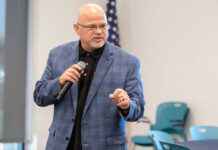
I’d like to spend some time this month talking about our county’s continued efforts to plan for tomorrow’s transportation systems. The focus in these columns during the past several months wandered away from this particular issue, but when you scan our horizon and look at the challenges that lie ahead (some in the immediate vicinity while others loom in the middle and far distance) for us, this one of transportation continues to stand as a topic of continuous interest.
County leaders, your Board of Supervisors and our transportation planners within the Public Works Department are engaged in some 22 different transportation planning initiatives that will impact virtually the entire county. Nearly all of those initiatives involve participation by representatives (elected and staff) of our cities and towns as well as Native American communities. Obviously not all projects involve everyone, but as we look to resolve these challenges on a regional basis, Pinal County believes in using as big a shovel as possible.
For example, we have just started a Transit Regional Feasibility and Implementation Study that will take some 18 months to complete. The study is designed to look countywide at these issues from the perspective of all modalities of travel: bus, rail, air and/or various combinations of these modes of transportation. Existing travel corridors will be examined with an eye to whether or not they might accommodate some form(s) of mass transit, population projections will be reviewed to see if future population densities would support some form of mass transit and, naturally, there’ll be some rough calculations as to how much each of these options might cost (i.e. cost per rider/mile, improvements to existing transportation facilities to accommodate a transit corridor, etc.).
The Hidden Valley Roadway Framework Study is near the end of the first phase after some three years of collaborative work between Pinal and Maricopa County, CAAG and MAG and local governments – including the cities of Maricopa and Casa Grande, and the Ak-Chin and Gila River Indian Communities. This framework study looks to create another channel of connectivity between central Pinal County and the western part of the Phoenix metroplex, using an extension of the Hassayampa Freeway corridor. Once adopted by CAAG and MAG, the study will be made part of BQ/AZ, which is ADOT’s master plan for the state’s transportation corridors. I might add that I was successful in getting HOV lanes and mass transit corridors attached to the major corridors.
Work continues on the next phase of the North-South Freeway, which is to run from the Apache Junction to the Red Rock area – ADOT planners will now begin the work of attempting to define that alignment in a more specific way. That process, which will be a very public one, should take several years before completion. Before I leave this topic, my hat’s off to ADOT Director John Halikowski, who has reinvigorated ADOT. We’re getting a lot of his attention, and I’m confident that it’ll benefit us and Arizona in the long run.
In closing, I want to offer an eye-witness report of the recent (late last month) visit to Superior by U.S. Secretary of the Interior Ken Salazar, along with members of our Congressional delegation led by Senator McCain, and Representatives Kirkpatrick and Mitchell. They came to look at the proposed site of the Resolution Copper mining venture and to meet with local citizens so they could hear their concerns firsthand. As you may know, in order for the project to move forward, a swap of nearly 6,000 acres of privately owned land in exchange for some 2,400 acres of immediately adjacent federal land has to happen. Some members of the San Carlos Apache Indian Community have expressed opposition (as have some environmental groups), but the overwhelming sentiment among area residents favors the project. Certainly the economic benefits to Arizona and Pinal County over the 60-plus year lifespan of the venture stand to be huge.
I, and my colleagues on the Board of Supervisors, support this massive economic development engine that promises to revitalize the eastern portion of our county with jobs, a dramatic improvement of the quality of life, educational institutions, health care, etc. I don’t want to minimize the concerns of the tribal elders, and I’m heartened by the elders’ willingness to engage in a dialog with the highest levels of Resolution Copper’s management in finding a way to assuage their concerns and provide employment opportunities for tribal members as well. I look forward to a successful resolution of their differences and a “go” vote from Congress and a Presidential signature on the bill. Then another important piece of our economic self-determination will have fallen into place.
David Snider, Pinal County Supervisor, District 3
File photo









![City gave new manager big low-interest home loan City Manager Ben Bitter speaks during a Chamber of Commerce event at Global Water Resources on April 11, 2024. Bitter discussed the current state of economic development in Maricopa, as well as hinting at lowering property tax rates again. [Monica D. Spencer]](https://www.inmaricopa.com/wp-content/uploads/2024/04/spencer-041124-ben-bitter-chamber-property-taxes-web-218x150.jpg)





